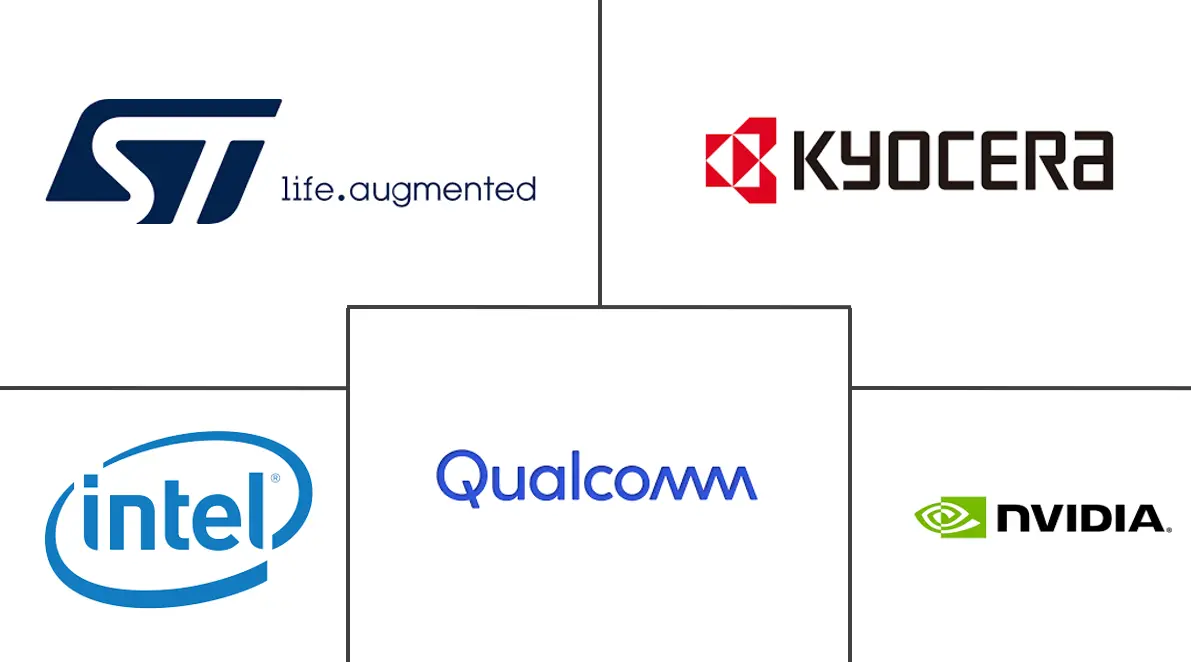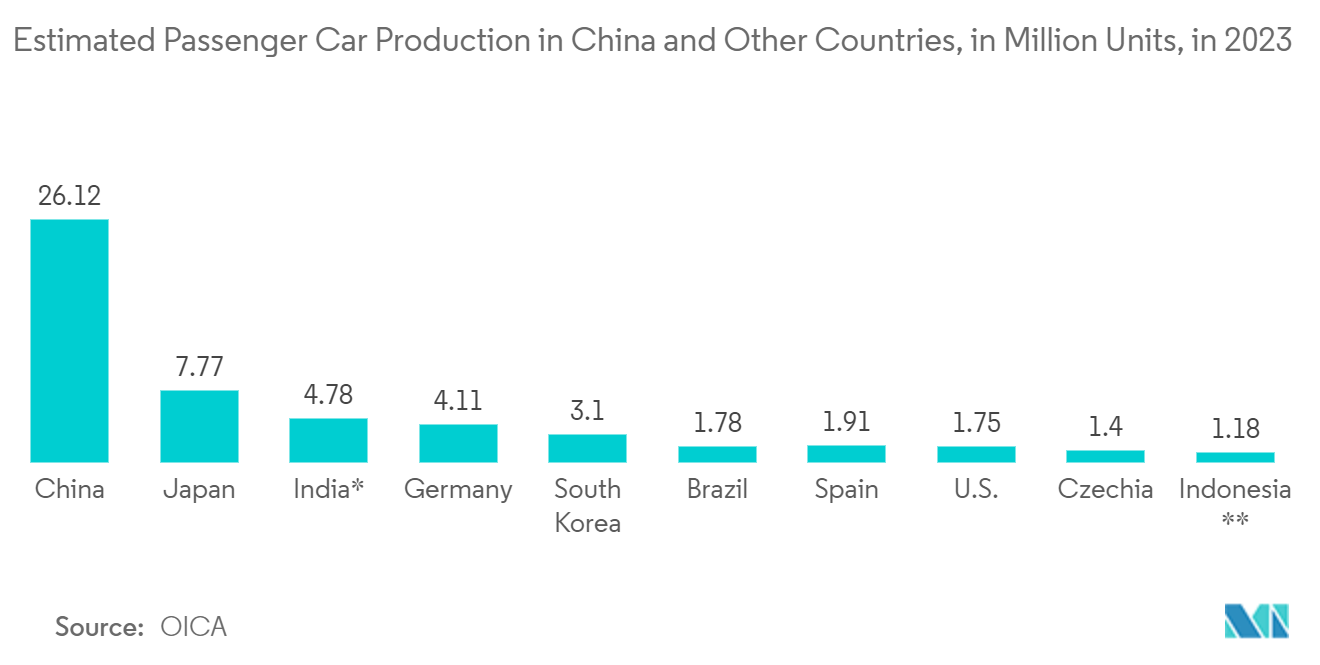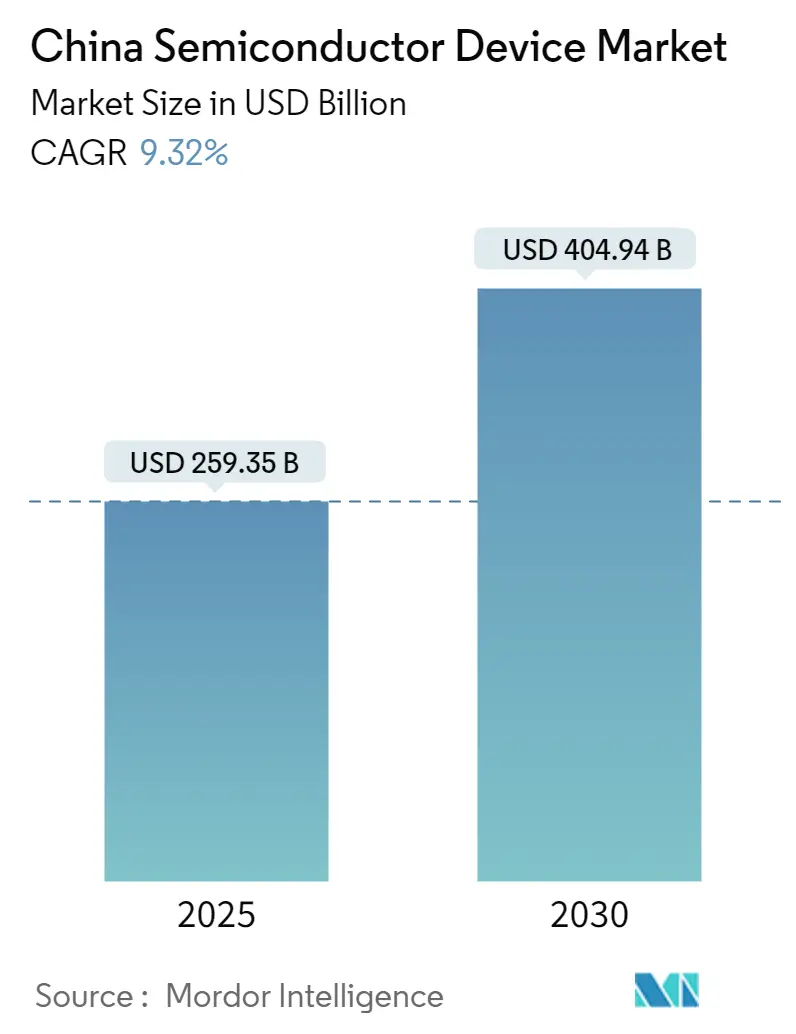
| Study Period | 2019 - 2030 |
| Base Year For Estimation | 2024 |
| Forecast Data Period | 2025 - 2030 |
| Market Size (2025) | USD 259.35 Billion |
| Market Size (2030) | USD 404.94 Billion |
| CAGR (2025 - 2030) | 9.32 % |
| Market Concentration | Low |
Major Players*Disclaimer: Major Players sorted in no particular order |
China Semiconductor Device Market Analysis
The China Semiconductor Device Market size is estimated at USD 259.35 billion in 2025, and is expected to reach USD 404.94 billion by 2030, at a CAGR of 9.32% during the forecast period (2025-2030).
However, as the supply chain gradually recovered in the Q2 of 2020, governments enabled fiscal policies to recover the economy. These factors, combined with the rise of the stay-at-home economy, led to increased restocking demand from downstream clients, boosting semiconductor revenue.
- Also, the semiconductor shortage caused by the COVID-19 pandemic prompted players to focus on increasing production capacity. For instance, the Semiconductor Manufacturing International Corp (SMIC) announced aggressive plans to double its production capacity by 2025 by constructing new chip fabrication plants in various cities, including a September 2021 announcement to establish a new factory in Shanghai's free trade zone.
- According to the Ministry of Industry and Information Technology (MIIT), China aims to have 2 million installed 5G base stations in 2022 to expand the country's next-generation mobile network. The Chinese mainland currently has 1.425 million installed 5G base stations that support more than 500 million 5G users nationwide, making it the most extensive network in the world, as per MIIT. The growing implementation of 5G in the country will increase the uptake of 5G-enabled devices.
- In China, the growth of the studied market can also be attributed to the booming electronics industry. Electronics is one of the largest industries in China and is a significant contributor to the country's overall economic growth. For instance, per the State Council of the People's Republic of China, during the two months from January to February 2022, the added value of major electronics manufacturers rose 12.7% year-on-year, compared with the 7.5% growth in the overall industrial sector in the country. China is the world's leading producer of electronic devices such as TVs, smartphones, laptops and PCs, refrigerators, and air conditioners.
- Additionally, several initiatives have been taken in recent years to boost the industry's growth. For instance, during the second pandemic wave, the Chinese government announced plans to expand the domestic market for electronic components to CNY 2.1 trillion (USD 327 billion) by 2023. The program covers components, materials, and manufacturing equipment used in areas such as smartphones, drones, 5G wireless, connected factories, electric vehicles, robotics, high-speed rail, and aerospace. Specifically, the Chinese government is looking to increase the output of semiconductors, sensors, magnets, fiber-optic equipment, and software, among others. Such initiatives create a positive growth outlook for the studied market.
- Further, the growing adoption of cloud computing in the country is another factor boosting the market growth. According to the China Academy of Information and Communications Technology (CAICT), by 2023, the size of China's cloud computing market will reach CNY 375.42 billion (USD 56.31 billion), increasing by 1.8 times compared with that of 2019, and the CAGR from 2019 to 2023 will be as high as 29.5%.
China Semiconductor Device Market Trends
Automotive Sector is Expected to Drive the Market
- As per vehicle production statistics, China was the largest automotive market in the world in 2021.The country is expected to retain its dominance in the automotive semiconductor market during the forecast period. The rising demand for vehicles in the country, coupled with favorable regulations and economic labor costs, has boosted local vehicle production.
- An increasing number of original equipment manufacturers (OEMs) are offering advanced automotive electronics in economic vehicle variants. The surging demand for comfort and safety features in today's vehicles is expected to drive the automotive semiconductor market in China. The Government of China has placed strategic emphasis on plug-in hybrid electric vehicles (EVs) and pure EVs while promoting the adoption of energy-efficient hybrid vehicles. Their sales are also increasing rapidly.
- The Chinese government plays a pivotal role in driving R&D and intends to make the country an R&D hub for vehicles and vehicle technologies. Also, China has incentives for electric cars, plug-in hybrids, and fuel-cell vehicles. The use of basic engine semiconductors to lower carbon emissions in passenger cars is also expected to contribute to the growth of the automotive semiconductor market.
- In 2023, China outpaced all countries in passenger car production, manufacturing approximately 26.1 million units, as reported by OICA. China retained its position as the leading producer of light vehicles. Homegrown manufacturers like SAIC, Changan, Dongfeng, Geely, and BAIC, the latter in partnership with Mercedes-Benz Group, are notably expanding their market presence. China's success in vehicle production, spanning both passenger cars and trucks, owes much to its strategic joint ventures with international counterparts.
Consumer Electronics is Expected to Hold Significant Market Share
- Most consumer electronics, like mobile phones, laptops, game consoles, microwaves, and refrigerators, operate with semiconductors, such as integrated chips, diodes, and transistors. The high demand for these devices is a crucial factor contributing to the growth of the studied market.
- Integrated circuits are widespread in consumer electronics with microprocessor control, from cell phones and portable music players to gaming systems, personal computers, and other digital devices. An integrated circuit (IC) or chip is a highly sophisticated device packing up many electronic components like transistors, resistors, and capacitors into an area of a few square centimeters on a silicon wafer.
- Further, semiconductor memory is a digital electronic data storage device implemented with semiconductor electronic devices on an integrated circuit. Different types of memory are available, such as dynamic random access memory (DRAM), static random access memory (SRAM), NOR Flash, NAND Flash, read-only memory (ROM), and erasable programmable read-only memory (EPROM). They find widespread application in digital consumer products like PCs, laptops, cameras, and phones.
- For instance, in July 2022, Samsung unveiled the world's first 24 Gbps GDDR6 DRAM chips, made for high-performance general processing units (GPUs) used in gaming PCs, laptops, and consoles. Also, in May 2023, NEO Semiconductor, a developer of innovative technologies for 3D NAND flash and DRAM memory, announced the launch of its ground-breaking technology, 3D X-DRAM. This development is the world's first 3D NAND-like DRAM cell array targeted to solve DRAM's capacity bottleneck and replace the entire 2D DRAM market.
- Further, trends such as consumer IoT (Internet of Things) have fueled the demand for semiconductor devices. An ideal example of consumer IoT is the smart home, where electronic equipment, heating, ventilating, and air conditioning (HVAC) systems, lighting, and appliances are all monitored and controlled from a central hub. IoT applications cannot work without sensors and integrated circuits, so all IoT devices require semiconductors, which creates a huge growth potential for the market studied.
- According to National Bureau of Statistics of China, in April 2024, China's cellphone production volume reached nearly 126 million units. Building on its momentum from the production of almost 1.4 billion cellphones by November 2023. China stands as a global leader in cellphone manufacturing, poised for further growth. Not only renowned for its manufacturing prowess, but China's domestic market has also emerged as one of the world's largest for mobile phones.
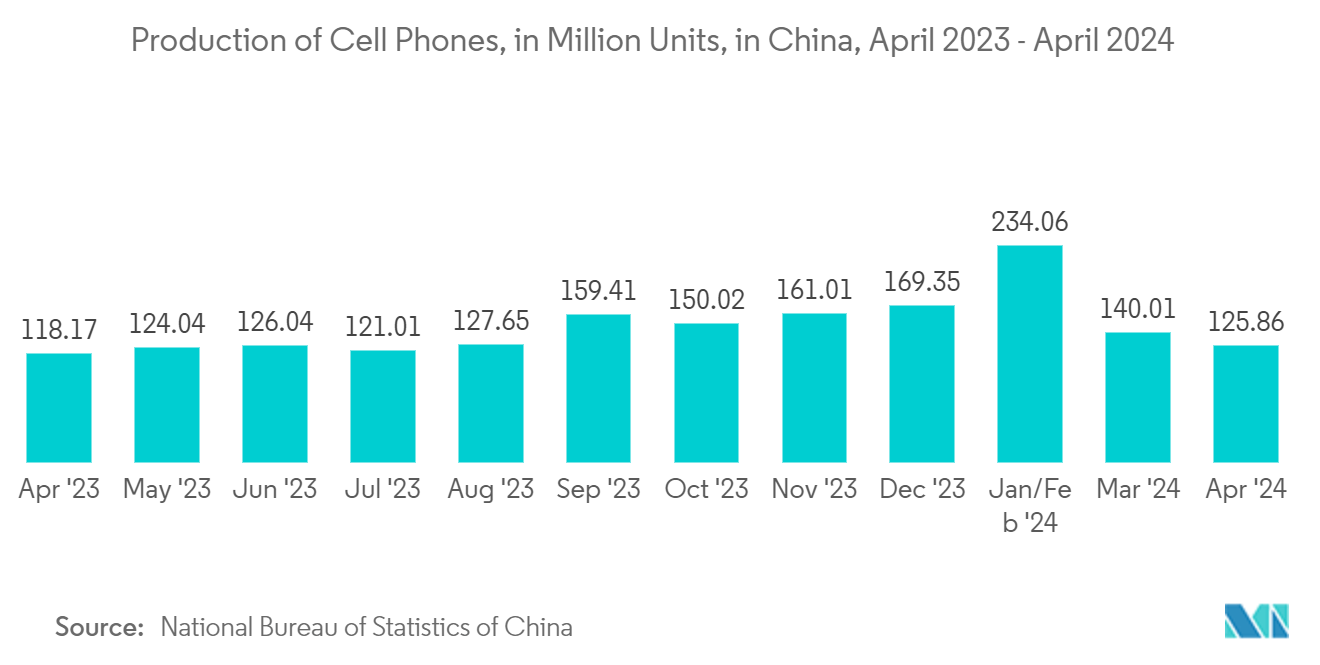
China Semiconductor Device Industry Overview
The China semiconductor device market fluctuates with growing consolidation, technological advancement, and geopolitical scenarios. Further, the competition will only increase in a market where the sustainable competitive advantage through innovation is considerably high. In such a situation, the brand identity plays a significant role, considering the importance of quality that the end-users expect from a semiconductor manufacturing player.
With the presence of prominent market incumbents, such as Intel Corporation, Nvidia Corporation, Kyocera Corporation, Qualcomm Incorporated, STMicroelectronics NV, Micron Technology Inc., Xilinx Inc., NXP Semiconductors NV, Toshiba Corporation, Texas Instruments Inc., Taiwan Semiconductor Manufacturing Company (TSMC) Limited, SK Hynix Inc., Samsung Electronics Co. Ltd, the market penetration levels are also high.
In November 2022, Nvidia Corporation announced that it is offering a new advanced chip in China that meets recent export control rules to keep advanced technology out of China's hands.
In March 2022, Renesas Electronics Group, a global supplier of semiconductor solutions, announced the launch of the RZ/Five general-purpose microprocessor (MPU) based on the 64-bit RISC-V, the V central processing unit (CPU) instruction set architecture (ISA). This enhances Renesas' existing lineup of MPUs based on Arm CPU cores, expands customer choices and provides greater flexibility during product development.
China Semiconductor Device Market Leaders
-
Intel Corporation
-
Nvidia Corporation
-
Kyocera Corporation
-
Qualcomm Incorporated
-
STMicroelectronics NV
- *Disclaimer: Major Players sorted in no particular order
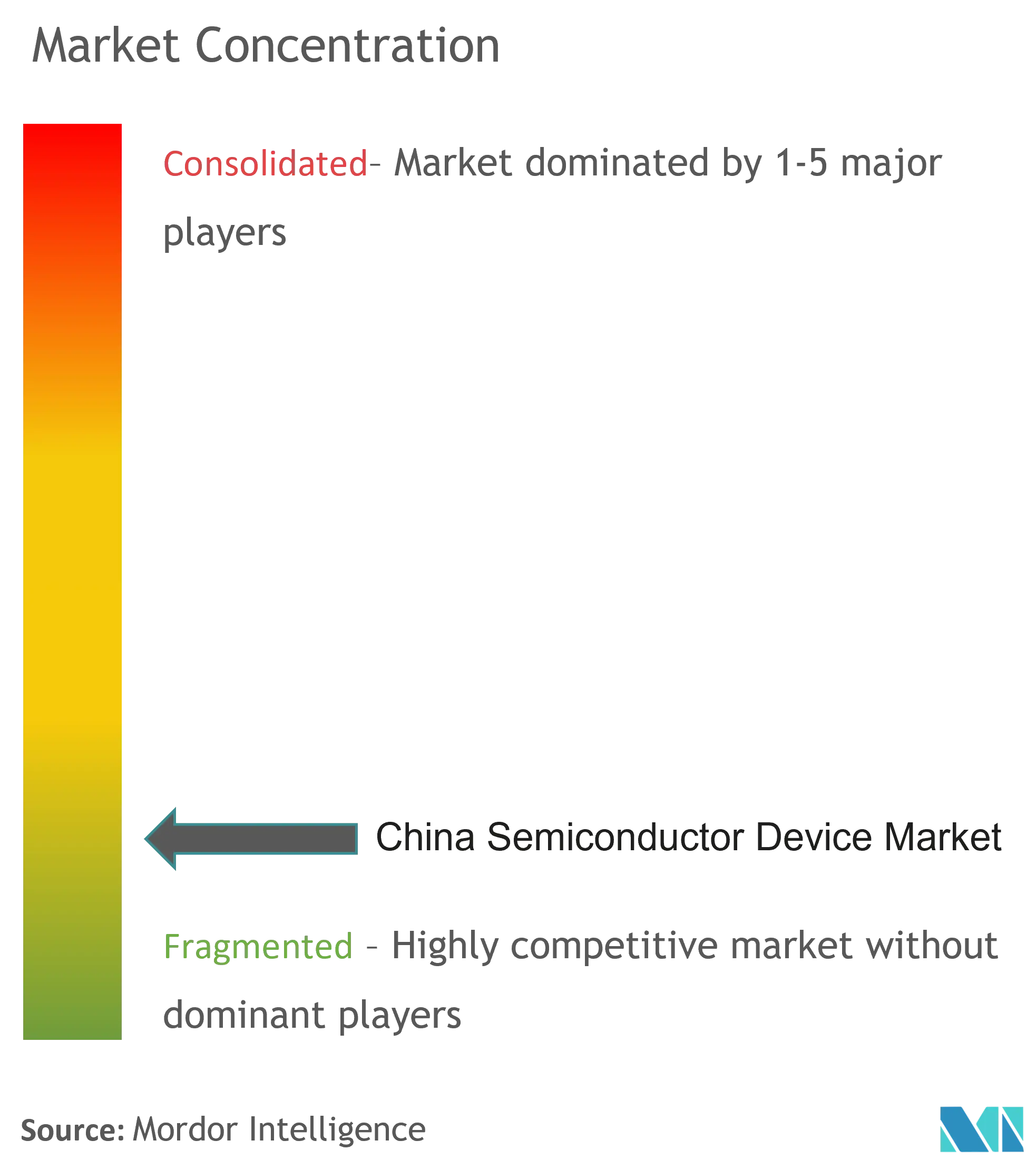
China Semiconductor Device Market News
- April 2023: Renesas Electronics Corp. has produced its first microcontroller (MCU) based on advanced 22-nm process technology. By employing state-of-the-art process technology, Renesas provides MCUs with higher performance at lower power consumption based on reduced core voltages. The process technology enables the integration of a feature set that includes functions such as radio frequency (RF). The advanced process node also uses a smaller die area, resulting in more minor chips with improved peripheral and memory integration.
- January 2022: WeEn Semiconductors' Global Operation Center launched a ceremony in Shanghai with the theme 'New Journey and United Strength." The event highlighted the revitalized image of WeEn semiconductors, symbolizing its progress and success in the industry. This significant occasion began an exciting chapter for the company, further strengthening its position in the global market.
China Semiconductor Device Industry Segmentation
A semiconductor device is an electronic component that relies on the electronic properties of semiconductor material for its function. Its conductivity lies between conductors and insulators. Semiconductor devices have replaced vacuum tubes in most applications. They conduct electric current in the solid state rather than as free electrons across a vacuum or as free electrons and ions through an ionized gas.
The China semiconductor device market is segmented by device type (discrete semiconductors, optoelectronics, sensors, and integrated circuits [analog, logic, memory, and micro [microprocessors, microcontrollers, and digital signal processors]]) and by end-user vertical (automotive, communication [wired and wireless], consumer electronics, industrial, computing/data storage, and other end-user verticals). The report offers market forecasts and size in value (USD) for all the above segments.
| By Device Type | Discrete Semiconductors | |||
| Optoelectronics | ||||
| Sensors | ||||
| Integrated Circuits | Analog | |||
| Logic | ||||
| Memory | ||||
| Micro | Microprocessors (MPU) | |||
| Microcontrollers (MCU) | ||||
| Digital Signal Processors | ||||
| By End-User Vertical | Automotive | |||
| Communication (Wired and Wireless) | ||||
| Consumer Electronics | ||||
| Industrial | ||||
| Computing/Data Storage | ||||
| Other End-User Verticals | ||||
China Semiconductor Device Market Research Faqs
How big is the China Semiconductor Device Market?
The China Semiconductor Device Market size is expected to reach USD 259.35 billion in 2025 and grow at a CAGR of 9.32% to reach USD 404.94 billion by 2030.
What is the current China Semiconductor Device Market size?
In 2025, the China Semiconductor Device Market size is expected to reach USD 259.35 billion.
Who are the key players in China Semiconductor Device Market?
Intel Corporation, Nvidia Corporation, Kyocera Corporation, Qualcomm Incorporated and STMicroelectronics NV are the major companies operating in the China Semiconductor Device Market.
What years does this China Semiconductor Device Market cover, and what was the market size in 2024?
In 2024, the China Semiconductor Device Market size was estimated at USD 235.18 billion. The report covers the China Semiconductor Device Market historical market size for years: 2019, 2020, 2021, 2022, 2023 and 2024. The report also forecasts the China Semiconductor Device Market size for years: 2025, 2026, 2027, 2028, 2029 and 2030.
Our Best Selling Reports
China Semiconductor Device Industry Report
Statistics for the 2025 China Semiconductor Device market share, size and revenue growth rate, created by Mordor Intelligence™ Industry Reports. China Semiconductor Device analysis includes a market forecast outlook for 2025 to 2030 and historical overview. Get a sample of this industry analysis as a free report PDF download.

